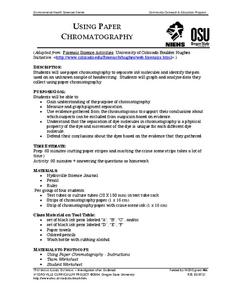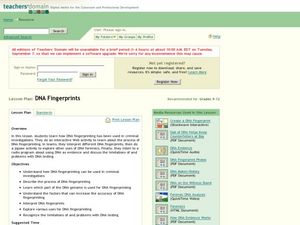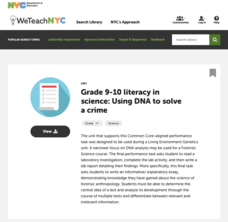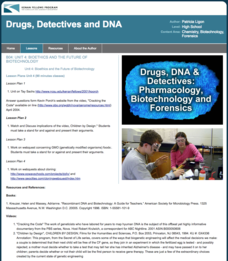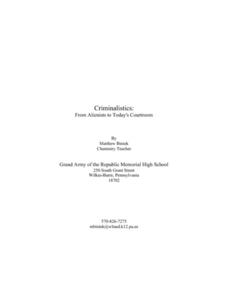North Carolina State University
Exploring Genetics Across the Middle School Science and Math Curricula
Where is a geneticist's favorite place to swim? A gene pool. Young geneticists complete hands-on activities, experiments, and real-world problem solving throughout the unit. With extra focus on dominant and recessive genes, Punnett...
Oregon State
Using Paper Chromatography
Through the analysis of paper chromatography to separate ink from the pen found at the crime scene, learners analyze the different stains and through calculations determine the thief.
Curated OER
Archaeological Detectives
Students, in groups, examine in depth one aspect of forensic archaeology to determine the skeleton's age, gender, and possible cause of death. To do so, students must first explain what is involved in each aspect of forensic archaeology.
Curated OER
Flesh Eating Bugs, Moldy Corpses, The Trail of a Killer
Students read about how forensic entomologists use maggots to solve murders. In this forensic science instructional activity, students read an article and answer questions. They go to different websites about evidence and...
Curated OER
Lewis and Clark in Columbia River Country
Learners interpret historical evidence presented in primary and secondary resources. In this research skills lesson, students research the death of Meriwether Lewis using forensic evidence presented in primary...
Curated OER
Genetics 5 Technology
Students, after studying extraction and gel electrophoresis, recombinant DNA, transgenic organisms, and reproductive cloning, summarize the main concepts in DNA technology. They analyze the applications of DNA: forensics, medicine,...
Curated OER
DNA Fingerprints
High schoolers interpret different DNA fingerprints, then do a jigsaw activity to explore other uses of DNA forensics. They listen to a radio program about using DNA as evidence and discuss the limitations of and problems with DNA testing.
Curated OER
Splatter Spread
Students assemble a potato cannon following directions. In groups, they analyze the spread pattern of paint soaked projectiles and discover the relationship between scatter and distance. They role play the role of a forensic scientist...
Curated OER
Aviation History/Writing and Forensic Science
In this aviation lesson, students research Charles Augustus Lindbergh and other early aviators and their flying machines. They then write a letter to one of the aviators asking questions about the mechanics of flight and their flying...
Curated OER
"A Test for Murder"
Students compare and contrast the strengths and weaknesses of their observation abilities as they examine forensic evidence provided by a classroom simulation of a crime committed.
New York City Department of Education
Grade 9-10 Literacy in Science: Using DNA to Solve a Crime
Scholars become detectives and use science to solve a crime! A complete unit introduces DNA and includes hands-on activities that have learners model DNA and extract it from different food types. A culminating activity challenges...
Kenan Fellows
Unit 2: DNA Analysis
Ever wonder how they solve those mysterious murders in TV crime dramas? The second of four units in a Biotechnology series introduces scholars to the many methods of DNA analysis. Pupils create and run their own gel electrophoresis...
Kenan Fellows
Unit 4: Bioethics and the Future of Biotechnology
What's the future of biotechnology? Explore a hot topic in the fourth and final unit in a series of Biotechnology lessons. Learners develop an understanding of the many issues in bioethics, then create an argument for or against the role...
Constitutional Rights Foundation
Criminal Justice in America
The allure of true crime television shows often leads to intrigue of the criminal justice system. Using a six-unit curriculum, learners explore criminology and the justice system in the United States. Topics include the police, trial...
Curated OER
Blood, I Presume?
Students explain the value of blood in trials. In this DNA lesson students work together to collect and share information and ideas that they come up with after learning how to distinguish blood from other stains.
Curated OER
America's Stone Age Explorers
Students watch a Nova program examining the earliest in habitants of the Americas. In groups. they take notes on various topics covered in the program. Among the topics covered are: the Clovis people, Solutrean culture, migration...
Curated OER
Forensic Science - A Paternal Case
Ninth graders identify and relate terms in biotechnology. They discuss genetic engineering in the world today. Students are given a worksheet to determine the father in the paternal case. They complete answers on the worksheet.
Curated OER
Science: The Big Sleep and Criminalistics
Students view the film, "The Big Sleep" focusing on the investigation techniques employed by the main character. Throughout the viewing, students respond to essay questions explaining actions by the characters. The questions center on...
Curated OER
Blood Business
Students identify the different kinds of blood. In this biology instructional activity, students investigate the antigens, agglutinins and Rh factor using their own blood. They use Punnett squares to predict blood type of offspring.
Curated OER
Science: Criminalistics - A New Look at Crime
Students examine the world of forensic science, focusing on fingerprint analysis. In the lesson plan, they implement a method by which fingerprints of class members are categorized and identified. Elementary students study...
Alabama Learning Exchange
Properties of Minerals
High schoolers explore the basic building blocks of our planet. In this minerals lesson students begin the process of forensics on the basis of investigation and drawing conclusions from observations.
Curated OER
Benefits of Biotechnology
Various aspects about the impact of biotechnology in our everyday lives, and many examples of its application are given in these slides. Designed with multiple fonts, the style should be appealing to youth.
Olomana School
Mixtures and Solutions: Paper Chromatography Experiment
Why does some ink bleed through paper, and other ink doesn't? Practice some paper chromatography to separate the colors from a pen with an interactive experiment for middle and high schoolers. Learners use a variety of solutions to track...
EngageNY
Newton’s Law of Cooling, Revisited
Does Newton's Law of Cooling have anything to do with apples? Scholars apply Newton's Law of Cooling to solve problems in the 29th installment of a 35-part module. Now that they have knowledge of logarithms, they can determine the decay...
Other popular searches
- Forensic Science
- Forensic Science Powerpoint
- Forensic Science Project
- Forensic Science Blood Type
- Forensic Anthropology
- Forensics and Microscopes
- Dna Technology in Forensics
- Vocabulary Forensic Science
- Forensic Science Lab
- Forensic Science Power Point
- Crime Scene Forensics
- Forensic Entomology

